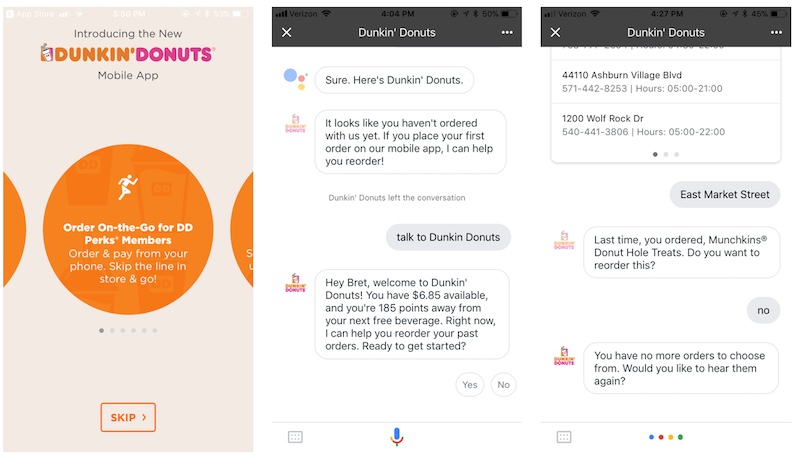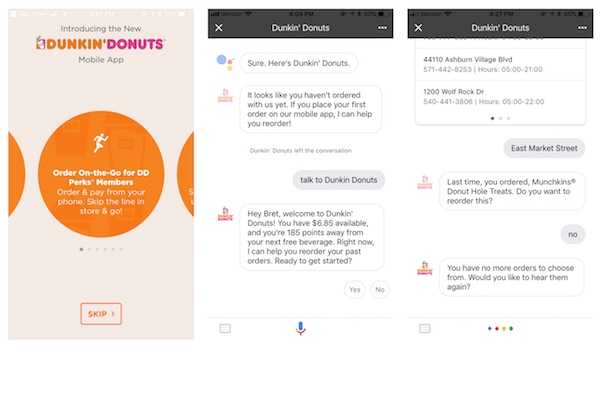Dunkin’ Donuts Joins the Voice Commerce Club
![]() Dunkin’ Donuts last month announced that it was integrating Google Assistant with its mobile ordering app. The company is following the voice commerce lead set by Starbucks which last year introduced an Alexa skill to enable voice ordering in the U.S. More recently, Starbucks has extended that model to supporting Samsung’s Bixby voice assistant in Korea. Dunkin’ Donuts also has an Alexa skill, but it doesn’t allow ordering. It has a trivia game and will tell you “fun facts” about doughnuts and coffee.
Dunkin’ Donuts last month announced that it was integrating Google Assistant with its mobile ordering app. The company is following the voice commerce lead set by Starbucks which last year introduced an Alexa skill to enable voice ordering in the U.S. More recently, Starbucks has extended that model to supporting Samsung’s Bixby voice assistant in Korea. Dunkin’ Donuts also has an Alexa skill, but it doesn’t allow ordering. It has a trivia game and will tell you “fun facts” about doughnuts and coffee.
The Google Assistant voice app enables Dunkin’ Donuts account holders to place reorders of past purchases. You cannot simply order something that you haven’t ordered previously, but it does bring Dunkin’ Donuts into voice commerce for the first time. Starbucks does not have a Google Assistant app today. So, both companies have a voice assistant that enables ordering, but on different platforms. It is also worth noting that the Dunkin’ Donuts’ Google Assistant app is not supported currently on Google Home. You can only access it through Google Assistant on Android or the Google Assistant app on iOS. The mobile support is important, because the ordering is mostly likely to take place while consumers are out of the home. One reason it is not on Google Home is highlighted below.
Account Linking to Reordering
The process starts with account linking which I set up by downloading the Dunkin’ Donuts mobile app and registering. I first attempted to initiate the process through Google Assistant, but it simply took me to a login screen for account linking so that was a gate I could not pass. After registering on the mobile app, I went back to Google Assistant and completed the account linking. This is where I learned that I could only reorder past purchases. So, back to the mobile app I went and placed an order for 10 Munchkins (i.e. Donut Holes).

When I returned to Google Assistant, I asked to place an order and the app asked if it could confirm my location with Google Assistant. This was surprising since I had already entered my location data in the Dunkin’ Donuts app when I set up my account. After I said “yes,” Google Assistant offered three nearby store locations where I could pick up an order. I was able to either tap the screen or speak the location. However, I was required to view the locations on the screen to know the options. There was no audible recitation of the locations. This is likely one reason why Google Home is not currently supported.
From there, I was only offered an opportunity to reorder. I placed the order and then it asked me to verify my Google email which was a different email address than I signed up for with the Dunkin’ Donuts app. It was the email and password linked to my Google Assistant app. Also, when it came time to pay, it actually debited my credit card linked to Google Assistant and not the credit card I had linked to the Dunkin’ Donuts account. This also meant I could not use the stored balance on my new Dunkin’ Donuts account. Nonetheless, the order went through after I confirmed the payment option on the screen. Both the mobile order and the Google Assistant order were ready for me when I arrived for pick-up. I didn’t wait in line or even speak to anyone in the store. My receipts were on the bags with my name ready to be whisked away.
More Work to Be Done
As exciting as voice commerce is, this use case demonstrates how it is not necessarily friction free. The amount of friction depends on the implementation. The fact that I had to offer permission to Google Assistant to share my location, then select the store displayed from a list on the screen and physically interact with the device to confirm payment all make it seem more like a modified mobile app purchase than a simple voice commerce order. In fact, reordering from the mobile app is probably faster because it already knows my preferred pick-up location, has my payment details confirmed and I can simply go to recent orders to place my reorder. In addition, I can create a new order.
This just reinforces that voice is different from the ecommerce we are accustomed to on the web and mobile. In addition to enabling voice interaction, related services such as location, user profiles and payment will need to evolve to better align with voice buying processes. Today, the simplicity of voice interaction is undermined by the friction of binding to processes originally designed to support visual user interaction. The good news is that these processes are surmountable as Amazon has demonstrated with ordering through Alexa and Google Assistant has with some Google Express features. What we need to understand is that just adding voice is not enough. The process must be rethought and simplifying the experience may require updates to existing services and infrastructure.
Voice Commerce on the Rise
OC&C Strategy Consultants found that about $1.8 billion of voice commerce was conducted in the U.S. in 2017 and forecasts that to rise to $40 billion by 2022. Adoption by everyday services like Uber for transportation and Dunkin’ Donuts for coffee are likely to be the key drivers of voice commerce growth. The transaction sizes may not be large, but loyal customers use them frequently and their numbers are large. The mobile era has focused on reducing friction in completing tasks while on the go. Voice can further reduced the friction barrier to commerce because you can simply speak and it is done. That is a particularly useful feature when you are driving or walking to pick up your usual coffee order. No thumbs required. And, you don’t have to wait in line when you arrive. It is ready to go. However, some other processes and infrastructure will need to change for consumers to fully realize the benefits of voice commerce for everyday purchases.
Voice Shopping to Reach $40 Billion in U.S. and $5 Billion in UK by 2022









